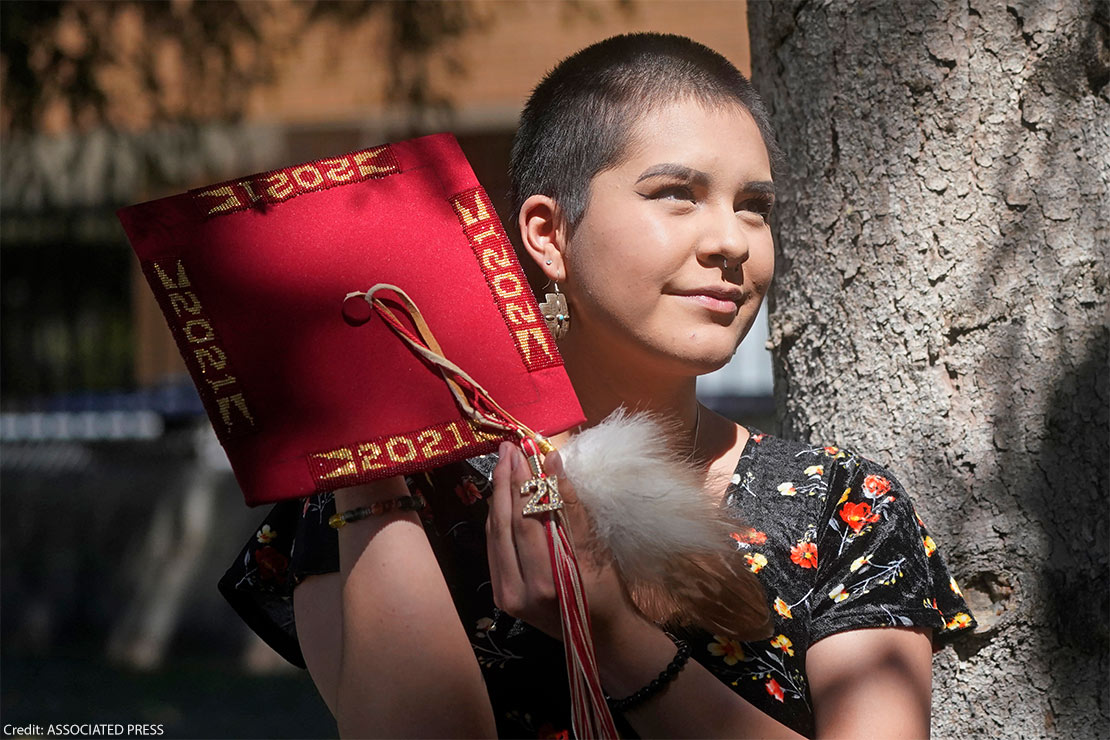“I hadn’t felt that powerful before that moment, standing up with my diploma, with my Native cap on and then shaking my principal’s hand.”
These are the words of Emalyce Kee, a Navajo and Rosebud Sioux student at a Utah public school. School officials told her to not wear a beaded cap or plumes to her graduation ceremony last year, but she did it anyway.
Efforts to stop students from wearing tribal regalia can’t be viewed in a vacuum. Indigenous students have long been mistreated and disadvantaged in educational settings.
Emalyce was not alone. Last year, another Indigenous student, Lena’ Black, was forced to remove an eagle feather from her graduation cap before her graduation ceremony in Oklahoma. Although federal law may, in some instances, protect Indigenous students’ cultural and religious right to wear tribal regalia during graduations, there are countless Indigenous students, like Emalyce and Lena’, who nevertheless face uncertainty and discrimination when they attempt to wear eagle feathers, beaded caps, sealskin caps, moccasins, or other tribal regalia during graduation ceremonies.
Graduation should be about celebrating students’ accomplishments and dreams for the future, and they should be able to honor their heritage without unnecessary and discriminatory obstacles. “I want this to never happen to another Native student … they ruined something she has worked her whole life to achieve,” Marci Black, mother of Lena’ Black, said in an interview.
The ACLU will continue to fight by ensuring that lawmakers hear directly from impacted students and join other states in protecting the rights of students.
Efforts to stop students from wearing tribal regalia can’t be viewed in a vacuum. Indigenous students have long been mistreated and disadvantaged in educational settings. Not too long ago, federal boarding schools were used as a tool of genocide, to forcibly remove Indigenous children from their families and tribes in order to erase their identities, languages, and cultural heritage. Continuing to strip Indigenous students of their tribal regalia at a crucial moment in their lives is a continuation of this horrific legacy.
But all hope is not lost. Indigenous students and communities, along with allies, have secured key victories protecting their right to wear tribal regalia. Their resilience means that other Indigenous students won’t have to go through the same difficulties. In recent years, nine states have passed bipartisan legislation to protect the right to wear tribal regalia — the most recent being Utah, following years of advocacy and organizing.
This year, three states are considering bills that would serve to protect the rights of Indigenous students:
- SB 429 in Oklahoma and AB 73 in Nevada are bills focused on protecting the rights of Indigenous students to wear tribal regalia.
- LB 630 in Nebraska is a broad bill that would protect students from discrimination based on hairstyles, natural hair, and certain head coverings. It also protects the right of Indigenous students to wear tribal regalia.
Lawmakers in Nebraska, Oklahoma, and Nevada are in the unique position to codify the rights of Indigenous students so that no student has to experience discrimination or the fear that they will be barred from expressing their culture and faith at graduation.
Alongside Tribal Nations and Indigenous communities, the ACLU and our affiliates have successfully advocated for the rights of students to wear tribal regalia in Montana, California, Arizona, and elsewhere, and are working nationwide to protect and advance Indigenous students’ rights to an inclusive and culturally relevant education. The ACLU will continue to fight by ensuring that lawmakers hear directly from impacted students and join other states in protecting the rights of students.

